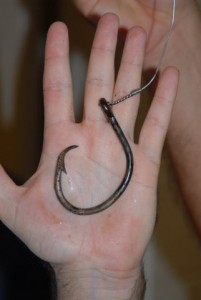News release, US Department of Land and Natural Resources (DLNR), 5 October 2012

The Department of Land and Natural Resources and NOAA Fisheries announce that since the beginning of 2012, NOAA Fisheries, DLNR, and partners have responded to 13 seal hooking incidents involving ten individual Hawaiian monk seals.
Due to early reporting, seven of the 11 live cases ended successfully with intervention from authorized federal and state agency monk seal responders.
Two cases ended in the seal ridding itself without intervention, and although an intervention was attempted, one seal remains hooked to this day.
Three cases ended in deaths.
Most recently, on Oct. 2, 2012, the monk seal locally known as “RK54” was found dead near the Ninini Light house on Kauai. The seal swallowed a hook, became entangled in the line, and died. RK54 was born in April 2011 to RK22 (mother of the “famous” KP2 who resides at Waikiki Aquarium).
NOAA and DLNR would like to take this opportunity to remind fishermen that monk seal deaths and injuries from fishing interactions can often be prevented, and adverse impacts to fishermen and seals can be reduced through early reporting of incidents. RK54 had prior fisheries interactions, but because of timely reporting and intervention, proper care was provided and the seal recovered.
“Monk seals are a vital part of Hawaii’s marine and cultural environment,” said William J. Aila, Jr., DLNR Chairperson. “While DLNR and NOAA seek to address all adverse impacts on Hawaiian monk seals, we want to acknowledge the cooperation of Hawaii fishermen and emphasize that we do not consider fishing interactions in the main Hawaiian Islands to currently pose a major threat to monk seal recovery.”
NOAA Fisheries Service data indicate that a total of 83 hooking-related interventions have occurred over the past 10 years, with a total of nine incidents in 2011 and 13 incidents thus far in 2012.
“However, in only three cases, including one of the recent cases, have hookings been deemed the likely cause of a seal’s death,” Aila added. “We want to partner with the fishermen to further reduce impacts. Following the guidelines and reporting hookings can help make a relatively small impact become even smaller.”
The agencies offer guidelines, titled “Hawaiian Monk Seals and Fishing Interactions: Guidelines for Prevention, Safety and Reporting,” that describe actions fishermen can take to avoid seal hookings and entanglement, and to reduce fishing gear and bait loss. The guidelines also stress the importance of reporting all fishing interactions.
The guidelines are available at the following link.
The toll-free, 24/7 reporting hotline for all fishing interactions and other marine mammal incidents is: 1-888-256-9840. NOAA and DLNR urge all fishermen and other ocean users to write down this hotline and/or save it in their mobile phones for timely use whenever a seal is hooked or entangled. “As the numbers of successful interventions from this year show, reporting early is important to the potential survival of the seal in question,” said David Schofield, Marine Mammal Health and Response Program Manager, NOAA NMFS PIRO.
Timely reporting of monk seal fishing interactions is beneficial in at least two ways:
1. First, reporting an interaction as soon as possible can help save a seal’s life or minimize seal injury. In at least three previous cases, real-time reporting of seals that had ingested hooks resulted in successful treatment and release of the seal back to the wild. These seals probably would have died without this intervention. On numerous other occasions, fishermen have provided timely reporting of less severe hooking and entanglements that were not immediately life-threatening, but could have become life-threatening if not responded to. These timely reports have allowed response network members to get out to the location in time to locate the seal and safely remove the gear.
2. The second benefit to timely reporting is that it helps federal and state managers and researchers better understand how fishery interactions occur and thereby helps guide the development and testing of improved methods to prevent and mitigate interactions. By reporting and documenting interactions, fishermen can partner with NOAA and DLNR to find better non-regulatory methods to effectively keep seals away from fishing gear and fishing areas, while also allowing for monk seal conservation and recovery.
Source: News release, US Department of Land and Natural Resources (DLNR), 5 October 2012
